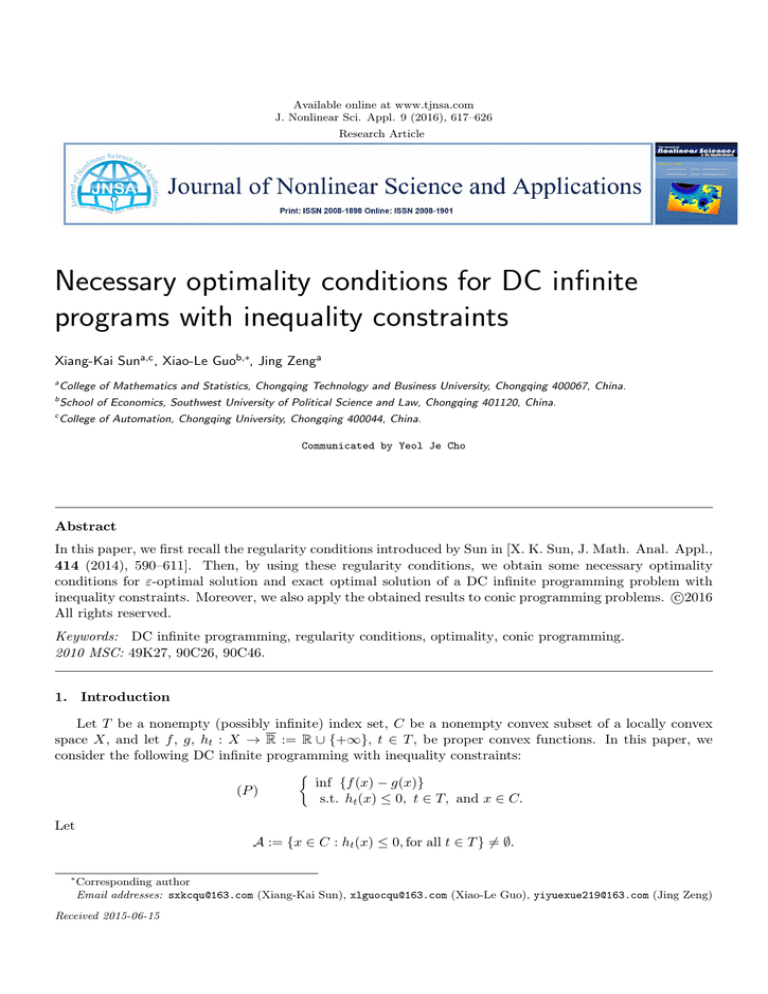
Available online at www.tjnsa.com
J. Nonlinear Sci. Appl. 9 (2016), 617–626
Research Article
Necessary optimality conditions for DC infinite
programs with inequality constraints
Xiang-Kai Suna,c , Xiao-Le Guob,∗, Jing Zenga
a
College of Mathematics and Statistics, Chongqing Technology and Business University, Chongqing 400067, China.
b
School of Economics, Southwest University of Political Science and Law, Chongqing 401120, China.
c
College of Automation, Chongqing University, Chongqing 400044, China.
Communicated by Yeol Je Cho
Abstract
In this paper, we first recall the regularity conditions introduced by Sun in [X. K. Sun, J. Math. Anal. Appl.,
414 (2014), 590–611]. Then, by using these regularity conditions, we obtain some necessary optimality
conditions for ε-optimal solution and exact optimal solution of a DC infinite programming problem with
c
inequality constraints. Moreover, we also apply the obtained results to conic programming problems. 2016
All rights reserved.
Keywords: DC infinite programming, regularity conditions, optimality, conic programming.
2010 MSC: 49K27, 90C26, 90C46.
1. Introduction
Let T be a nonempty (possibly infinite) index set, C be a nonempty convex subset of a locally convex
space X, and let f , g, ht : X → R := R ∪ {+∞}, t ∈ T , be proper convex functions. In this paper, we
consider the following DC infinite programming with inequality constraints:
inf {f (x) − g(x)}
(P )
s.t. ht (x) ≤ 0, t ∈ T, and x ∈ C.
Let
A := {x ∈ C : ht (x) ≤ 0, for all t ∈ T } =
6 ∅.
∗
Corresponding author
Email addresses: sxkcqu@163.com (Xiang-Kai Sun), xlguocqu@163.com (Xiao-Le Guo), yiyuexue219@163.com (Jing Zeng)
Received 2015-06-15
X.-K. Sun, X.-L. Guo, J. Zeng, J. Nonlinear Sci. Appl. 9 (2016), 617–626
618
Then, the problem (P ) can be rewritten as:
(P )
inf {f (x) − g(x) + δA (x)}.
x∈X
This kind of DC programming problem plays an interesting and important part in the field of nonconvex
optimization since it has numerous applications in Chebyshev approximation, transportation problems,
cooperative games, engineering design, optimal control, robust optimization, etc.
Recently, many important results have been established for different kinds of DC programming in the
last decades, see [4, 5, 6, 7, 10, 11, 12, 14, 15, 16, 17, 18, 19, 20, 22, 23] and the references therein. Here, we
specially mention the works on duality and optimality due to [5, 11, 12, 19, 20]. More precisely, by using the
properties of the epigraph of the conjugate functions, Dinh et al. [5] introduced a closedness qualification
condition and employed it to deriving qualified necessary optimality conditions for local minimizers of DC
infinite programs in a Banach space. Fang and Zhao [11] first introduced the local and global KKT type
conditions for a DC optimization problem. Then, by using properties of the subdifferentials of the involved
functions, they obtained some sufficient and/or necessary conditions for these two types of optimality conditions. By using the notions of strong subdifferential and epsilon-subdifferential, Guo and Li [12] obtained
necessary and sufficient optimality conditions for an epsilon-weak Pareto minimal point and an epsilonproper Pareto minimal point of a DC vector optimization problem. Sun and Li [19] obtained weak and
strong duality assertions for extended Ky Fan inequalities with DC functions. They also apply their dual
problems to a convex optimization problem and a generalized variational inequality problem. By using the
properties of the epigraph of the conjugate functions, Sun, et al. [20] introduced a closedness qualification
condition and employed it to investigate duality and Farkas-type results for a DC infinite programming
problem.
On the other hand, in order to characterize optimality conditions for an optimization problem, constraint
qualifications involving epigraphs (first introduced in [3]) have been introduced and extensively used by many
authors, see e.g. [2, 4, 5, 6, 9, 11, 21] and the references therein. Here, we just mention the work by Sun
in [16]. By using the properties of the epigraph of the conjugate functions, Sun [16] introduced some
new regularity conditions for (P ). Then, the author investigated some characterizations of these regularity
conditions. By using these regularity conditions, the author completely characterized Fenchel-Lagrange
dualities and Farkas-type results for (P ). However, to the best of our knowledge, there is no paper to
deal with ε-optimal solution and exact optimal solution of (P ) in terms of the new regularity conditions
introduced by Sun [16]. So, the purpose of this paper is to use the regularity conditions introduced by Sun
[16] to establish some necessary optimality conditions of ε-optimal solution and exact optimal solution for
the problem (P ). Moreover, we also apply the obtained results to conic programming problems.
The paper is organized as follows. In Section 2, we recall some notions and give some preliminary
results. In Section 3, we first recall some new regularity conditions introduced in [16]. Then, by using these
new regularity conditions, we establish some necessary and/or sufficient optimality conditions of ε-optimal
solution and exact optimal solution for DC and convex programs. In Section 4, we apply the proposed
approach to investigate optimality conditions of ε-optimal solution and exact optimal solution for conic
programming problems.
2. Mathematical Preliminaries
Throughout this paper, let X be a real locally convex vector space with its continuous dual space X ∗ ,
endowed with the weak∗ topology w(X ∗ , X). We always use the notation h·, ·i for the canonical paring
between X and X ∗ . Let D be a set in X, the interior (resp. closure, convex hull, convex cone hull) of D
is denoted by intD (resp. clD, coD, coneD). Thus if W ⊆ X ∗ , then clW denotes the weak∗ closure of W .
We shall adopt the convention that coneD = {0} when D is an empty set. Let D∗ = {x∗ ∈ X ∗ : hx∗ , xi ≥
0, ∀x ∈ D} be the dual cone of D. The indicator function δD : X → R of X is defined by
0,
if x ∈ D,
δD (x) =
+∞, if x 6∈ D.
X.-K. Sun, X.-L. Guo, J. Zeng, J. Nonlinear Sci. Appl. 9 (2016), 617–626
619
The support function σD : X ∗ → R of D is defined by
σD (x∗ ) = sup hx∗ , xi.
x∈D
Further, let RT be the product space of λ = (λt )t∈T with λt ∈ R for all t ∈ T , let R(T ) be collection of
(T )
λ ∈ RT with λt 6= 0 for finitely many t ∈ T , and let R+ be the positive cone in R(T ) defined by
n
o
(T )
R+ := λ ∈ R(T ) : λt ≥ 0 for all t ∈ T .
Given u ∈ RT and λ ∈ R(T ) , and denoting supp λ := {t ∈ T : λt =
6 0}, we have
X
X
hλ, ui :=
λt ut =
λt ut .
t∈T
t∈supp λ
Let f : X → R be an extended real-valued function. The effective domain and the epigraph are defined by
dom f = {x ∈ X : f (x) < +∞}
and
epi f = {(x, r) ∈ X × R : f (x) ≤ r},
respectively. f is said to be proper, if its effective domain is nonempty. The conjugate function f ∗ : X ∗ → R
of f is defined by
f ∗ (x∗ ) = sup {hx∗ , xi − f (x)} .
x∈X
The lower semicontinuous hull cl f : X → R of f is defined by
epi (cl f ) = cl (epi f ),
where the topological closure is taken with respect to the product topology. Let x̄ ∈ dom f . For any ε ≥ 0,
the ε-subdifferential of f at x̄ is the convex set defined by
∂ε f (x̄) := {x∗ ∈ X ∗ : f (x) ≥ f (x̄) + hx∗ , x − x̄i − ε, ∀x ∈ X}.
When x̄ 6∈ dom f , we define that ∂ε f (x̄) = ∅. If ε = 0, the set ∂f (x̄) := ∂0 f (x̄) is the classical subdifferential
of convex analysis, that is,
∂f (x̄) = {x∗ ∈ X ∗ : f (x) ≥ f (x̄) + hx∗ , x − x̄i, ∀x ∈ X}.
It is easy to prove that for any x̄ ∈ dom f and x∗ ∈ X ∗ ,
f (x̄) + f ∗ (x∗ ) ≤ hx∗ , x̄i + ε ⇔ x∗ ∈ ∂ε f (x̄).
Moreover, following [13], we have
epi f ∗ =
[
{(x∗ , hx∗ , x̄i + ε − f (x̄)) : x∗ ∈ ∂ε f (x̄)}.
ε≥0
Let E be a convex set of X. The ε-normal set to E at a point x̄ ∈ E is defined by
NEε (x̄) := {x∗ ∈ X ∗ : hx∗ , x − x̄i ≤ ε, for any x ∈ E}.
If ε = 0, NE0 (x̄) is the normal cone NE (x̄) of convex analysis. Moreover, it is easy to see that
NEε (x̄) = ∂ε δE (x̄).
Now, let us recall the following result which will be used in the following section.
Lemma 2.1 ([1]). Let f : X → R be a proper convex function. Then (u, c) ∈ epi f ∗ if and only if
u(x) − c ≤ f (x), for any x ∈ X.
X.-K. Sun, X.-L. Guo, J. Zeng, J. Nonlinear Sci. Appl. 9 (2016), 617–626
620
3. ε-optimal solution for (P )
n this section, we first recall some new regularity conditions introduced in [16]. Then, by using these
regularity conditions, we obtain some necessary optimality conditions for ε-optimal solution and exact
optimal solution of (P ). To this aim, we will make use of the following characteristic set K defined by
!
!
\
[
∗
K :=
epi f ∗ + cone
epi h∗t + epi δC
− (x∗ , g ∗ (x∗ )) .
x∗ ∈X ∗
t∈T
Definition 3.1 ([16], Definition 4.1). The family (f, g, δC , ht : t ∈ T ) is said to satisfy the closedness
condition (CC), iff
epi (f − g + δA )∗ = K.
In order to characterize ε-optimal solution of (P ) in terms of this constraint qualification, we need the
following lemma.
Lemma 3.2. x̄ ∈ A ∩ dom (f − g) is an ε-optimal solution of (P ) if and only if
(0, g(x̄) − f (x̄) + ε) ∈ epi (f − g + δA )∗ .
Proof. Note that x̄ ∈ A is an ε-optimal solution of (P ) if and only if for any x ∈ X,
(f − g + δA )(x) ≥ (f − g + δA )(x̄) − ε = f (x̄) − g(x̄) − ε.
Thus, by Lemma 2.1, we know that x̄ ∈ A is an ε-optimal solution of (P ) if and only if
(0, g(x̄) − f (x̄) + ε) ∈ epi (f − g + δA )∗ .
The proof is complete.
The following result provides a new necessary optimality condition for ε-optimal solution of (P ) under
the constraint qualification introduced in Definition 3.1.
Theorem 3.3. Let x̄ ∈ A ∩ dom (f − g). Assume that the family (f, g, δC , ht : t ∈ T ) satisfies the closedness
(T )
condition (CC) and x̄ is an ε-optimal solution of (P ). Then, for any x∗ ∈ ∂g(x̄), there exist λ ∈ R+ , η, ζ,
t ≥ 0 as t ∈ suppλ, such that
X
x∗ ∈ ∂η f (x̄) +
λt ∂t ht (x̄) + NCζ (x̄)
(3.1)
t∈suppλ
and
X
η+
λt (t − ht (x̄)) + ζ = ε.
(3.2)
t∈suppλ
Proof. By Lemma 3.2, we know that x̄ is an ε-optimal solution of (P ) if and only if
(0, g(x̄) − f (x̄) + ε) ∈ epi (f − g + δA )∗ .
Since the family (f, g, δC , ht : t ∈ T ) satisfies the closedness condition (CC), then
epi (f − g + δA )∗ = K.
Thus, if x̄ is an ε-optimal solution of (P ), then
!
(0, g(x̄) − f (x̄) + ε) ∈ K =
\
x∗ ∈X ∗
∗
epi f + cone
[
t∈T
epi
h∗t
!
+ epi
∗
δC
∗
∗
∗
− (x , g (x )) .
X.-K. Sun, X.-L. Guo, J. Zeng, J. Nonlinear Sci. Appl. 9 (2016), 617–626
621
Moreover, for any x∗ ∈ ∂g(x̄), we have
!
[
(0, g(x̄) − f (x̄) + ε) ∈ epi f ∗ + cone
epi h∗t
∗
+ epi δC
− (x∗ , g ∗ (x∗ )),
t∈T
i.e.,
!
(x∗ , g(x∗ ) + g(x̄) − f (x̄) + ε) ∈ epi f ∗ + cone
[
epi h∗t
∗
+ epi δC
.
t∈T
(T )
∗ and (v ∗ , β ) ∈ epi h∗ with t ∈ supp λ such
Then, there exist λ ∈ R+ , (u∗ , α1 ) ∈ epi f ∗ , (w∗ , α2 ) ∈ epi δC
t
t
t
that
X
(x∗ , g ∗ (x∗ ) + g(x̄) − f (x̄) + ε) = (u∗ , α1 ) +
λt (vt∗ , βt ) + (w∗ , α2 ),
t∈supp λ
which means that
x∗ = u∗ +
X
λt vt∗ + w∗
(3.3)
t∈supp λ
and
X
g ∗ (x∗ ) + g(x̄) − f (x̄) + ε = α1 + α2 +
λt βt .
t∈supp λ
Since
[
epi f ∗ =
{(u∗ , u∗ (x̄) + η − f (x̄)) : u∗ ∈ ∂η f (x̄)},
η≥0
epi
h∗t
[
=
{(vt∗ , vt∗ (x̄) + t − ht (x̄)) : vt∗ ∈ ∂t ht (x̄)}
t ≥0
and
∗
epi δC
=
[
{(w∗ , w∗ (x̄) + ζ) : w∗ ∈ ∂ζ δC (x̄)},
ζ≥0
there exist η, ζ, t ≥ 0 such that
u∗ ∈ ∂η f (x̄) and α1 = u∗ (x̄) + η − f (x̄),
vt∗ ∈ ∂t ht (x̄) and βt = vt∗ (x̄) + t − ht (x̄),
w∗ ∈ ∂ζ δC (x̄) and α2 = w∗ (x̄) + ζ.
By (3.3), we get
X
x∗ ∈ ∂η f (x̄) +
λt ∂t ht (x̄) + NCζ (x̄).
t∈suppλ
Moreover, by (3.3) and (3.4), we get
X
g ∗ (x∗ ) + g(x̄) − f (x̄) + ε = α1 + α2 +
λt βt
t∈supp λ
∗
= u (x̄) + η − f (x̄) + w∗ (x̄) + ζ +
X
λt (vt∗ (x̄) + t − ht (x̄))
t∈supp λ
= x∗ (x̄) + η +
X
t∈suppλ
λt (t − ht (x̄)) + ζ − f (x̄).
(3.4)
X.-K. Sun, X.-L. Guo, J. Zeng, J. Nonlinear Sci. Appl. 9 (2016), 617–626
622
Since x∗ ∈ ∂g(x̄), we have g ∗ (x∗ ) + g(x̄) = x∗ (x̄). Therefore,
X
η+
λt (t − ht (x̄)) + ζ = ε.
t∈suppλ
This completes the proof.
The following corollary establishes a necessary optimality conditions for exact optimal solution of (P ).
It is important to note that the result obtained is a refinement of the corresponding conditions established
recently in [4, 5] under a more restrictive constraint qualification and a different method.
Corollary 3.4. Let x̄ ∈ A∩dom (f −g). Assume that the family (f, g, δC , ht : t ∈ T ) satisfies the closedness
(T )
condition (CC) and x̄ is an exact optimal solution of (P ). Then, for any x∗ ∈ ∂g(x̄), there exists λ ∈ R+ ,
such that
X
x∗ ∈ ∂f (x̄) +
λt ∂ht (x̄) + NC (x̄)
t∈suppλ
and
λt ht (x̄) = 0, t ∈ suppλ.
Proof. Take ε = 0 in Theorem 3.3. It is easy to see that if x̄ is an exact optimal solution of (P ), then, for
(T )
any x∗ ∈ ∂g(x̄), there exist λ ∈ R+ , η, ζ, t ≥ 0 as t ∈ suppλ such that
X
x∗ ∈ ∂η f (x̄) +
λt ∂t ht (x̄) + NCζ (x̄)
t∈suppλ
and
η+
X
λt (t − ht (x̄)) + ζ = 0.
(3.5)
t∈suppλ
(T )
Form λ ∈ R+ , η, ζ, t ≥ 0, ht (x̄) ≤ 0 and (3.5), we get
η = t = −(λt ht )(x̄) = ζ = 0, for t ∈ suppλ.
Then, this proof is obtained by Theorem 3.3.
Finally, in this section, we consider a particular case of the DC problem (P ) with g(x) = 0 when (P )
reduces to the following convex infinite programming problem
inf f (x)
(P0 )
s.t. ht (x) ≤ 0, t ∈ T, and x ∈ C.
Since the function g = 0, the characteristic set K becomes
!
epi f ∗ + cone
[
epi h∗t
∗
+ epi δC
.
t∈T
Definition 3.5 ([8], Definition 3.1). The family (f, δC , ht : t ∈ T ) is said to satisfy the closedness condition
(CC)0 , iff
!
[
∗
∗
∗
∗
epi (f + δA ) = epi f + cone
epi ht + epi δC
.
t∈T
The next theorem shows that the specification of conditions (3.1) and (3.2) in this case is an necessary
and sufficient optimality conditions for (P0 ) under the closedness condition (CC)0 .
X.-K. Sun, X.-L. Guo, J. Zeng, J. Nonlinear Sci. Appl. 9 (2016), 617–626
623
Theorem 3.6. Let x̄ ∈ A ∩ dom f . Assume that the family (f, δC , ht : t ∈ T ) satisfies the closedness
(T )
condition (CC)0 . Then, x̄ is an ε-optimal solution of (P0 ) if and only if there exist λ ∈ R+ , η, ζ, t ≥ 0
as t ∈ suppλ such that
X
0 ∈ ∂η f (x̄) +
λt ∂t ht (x̄) + NCζ (x̄)
t∈suppλ
and
η+
X
λt (t − ht (x̄)) + ζ = ε.
t∈suppλ
Proof. We only need to prove the sufficient condition, since the necessary condition can be obtained easily
(T )
by g ≡ 0 in Theorem 3.3. Suppose that there exist λ ∈ R+ , η, ζ, t ≥ 0 as t ∈ suppλ such that
X
0 ∈ ∂η f (x̄) +
λt ∂t ht (x̄) + NCζ (x̄)
(3.6)
t∈suppλ
and
η+
X
λt (t − ht (x̄)) + ζ = ε.
(3.7)
t∈suppλ
By (3.6), there exist u∗ ∈ ∂η f (x̄), vt∗ ∈ ∂t ht (x̄) and w∗ ∈ NCζ (x̄) such that
X
u∗ +
λt vt∗ + w∗ = 0.
(3.8)
t∈supp λ
Let x ∈ A be arbitrary. Then, by the definitions of subdifferential and NCζ (x̄),
f (x) − f (x̄) ≥ u∗ (x − x̄) − η,
ht (x) − ht (x̄) ≥ vt∗ (x − x̄) − t ,
0 ≥ w∗ (x − x̄) − ζ.
Together with these inequalities, we get
f (x) − f (x̄) ≥ f (x) − f (x̄) +
X
λt ht (x) −
t∈supp λ
≥ u∗ +
λt ht (x̄) +
t∈supp λ
X
X
X
λt vt∗ + w∗ (x − x̄) − η +
t∈supp λ
λt ht (x̄)
t∈supp λ
X
λt (t − ht (x̄)) + ζ .
t∈suppλ
By (3.7) and (3.8), we get
f (x) − f (x̄) ≥ −ε.
which means that x̄ is an ε-optimal solution of (P0 ), and the proof is complete.
Similarly, we can easily get the following result for exact optimal solution of (P0 ). Let us mention that
it extends the recent result in [4, 5, 9] derived by a different constraint qualification and a different method.
Corollary 3.7. Let x̄ ∈ A ∩ dom f . Assume that the family (f, δC , ht : t ∈ T ) satisfies the closedness
(T )
condition (CC)0 . Then, x̄ is an exact optimal solution of (P0 ) if and only if there exists λ ∈ R+ , such that
X
0 ∈ ∂f (x̄) +
λt ∂ht (x̄) + NC (x̄)
t∈suppλ
and
λt ht (x̄) = 0, t ∈ suppλ.
X.-K. Sun, X.-L. Guo, J. Zeng, J. Nonlinear Sci. Appl. 9 (2016), 617–626
624
4. Applications
In this section, let X and Y be real locally convex Hausdorff topological vector spaces, C ⊆ X be a
nonempty convex set. Let S ⊆ Y be a nonempty closed convex cone which defined the partial order of
Y , namely: y1 ≤S y2 ⇐⇒ y2 − y1 ∈ S, for any y1 , y2 ∈ Y. We attach an element +∞ 6∈ Y which is a
greatest element with respect to “ ≤S ” and let Y • = Y ∪ {+∞}. The following operations are defined on
Y • : y + (+∞) = (+∞) + y = +∞ and t(+∞) = +∞, for any y ∈ Y and t ≥ 0. Let f, g : X → R be two
proper convex functions, and h : X → Y • be a proper S-convex function. For any p ∈ X ∗ , we consider the
following conic programming problem:
inf {f (x) − g(x)}
(P1 )
s.t. h(x) ∈ −S, and x ∈ C.
Pursuing the approach given in [16, Section 5], the problem (P1 ) can be viewed as an example of (P ). We
also use A to denote the solution set:
A := {x ∈ C : (λh)(x) ≤ 0, ∀λ ∈ S ∗ } = {x ∈ C : h(x) ∈ −S}.
And the characteristic set K introduced in Section 3 becomes
!
K1 :=
\
x∗ ∈X ∗
epi f ∗ +
[
∗
epi (λh)∗ + epi δC
− (x∗ , g(x∗ )) .
λ∈S ∗
Definition 4.1 ([16], Definition 5.1). The family (f, g, h, δC ) is said to satisfy the closedness condition
(CC)1 , iff
epi (f − g + δA )∗ = K1 .
By using the similar methods of Sections 3, we can also use this constraint qualification to establish the
corresponding results of the problem (P1 ).
Theorem 4.2. Let x̄ ∈ A ∩ dom (f − g). Assume that the family (f, g, h, δC ) satisfies the closedness
condition (CC)1 and x̄ is an ε-optimal solution of (P1 ). Then, for any x∗ ∈ ∂g(x̄), there exist λ ∈ S ∗ , η, ζ,
≥ 0 such that
x∗ ∈ ∂η f (x̄) + ∂ (λh)(x̄) + NCζ (x̄)
and
η + − (λh)(x̄) + ζ = ε.
Corollary 4.3. Let x̄ ∈ A ∩ dom (f − g). Assume that the family (f, g, h, δC ) satisfies the closedness
condition (CC)1 and x̄ is an exact optimal solution of (P1 ). Then, for any x∗ ∈ ∂g(x̄), there exists λ ∈ S ∗ ,
such that
x∗ ∈ ∂f (x̄) + ∂(λh)(x̄) + NC (x̄)
and
(λh)(x̄) = 0.
Finally, in this section, we consider a particular case of the problem (P1 ) with g(x) = 0 when (P1 )
reduces to the following convex programming problem
inf f (x)
(P2 )
s.t. h(x) ∈ −S, and x ∈ C.
Since the function g = 0, the characteristic set K becomes
[
∗
epi f ∗ +
epi (λh)∗ + epi δC
.
λ∈S ∗
X.-K. Sun, X.-L. Guo, J. Zeng, J. Nonlinear Sci. Appl. 9 (2016), 617–626
625
Definition 4.4 ([16], Definition 5.2). The family (f, h, δC ) is said to satisfy the closedness condition (CC)2 ,
iff
[
∗
epi (f + δA )∗ = epi f ∗ +
epi(λh)∗ + epi δC
.
λ∈S ∗
Theorem 4.5. Let x̄ ∈ A ∩ dom f . Assume that the family (f, h, δC ) satisfies the closedness condition
(CC)2 . Then, x̄ is an ε-optimal solution of (P2 ) if and only if there exist λ ∈ S ∗ , η, ζ, ≥ 0 such that
0 ∈ ∂η f (x̄) + ∂ (λh)(x̄) + NCζ (x̄)
and
η + − (λh)(x̄) + ζ = ε.
Corollary 4.6. Let x̄ ∈ A ∩ dom f . Assume that the family (f, h, δC ) satisfies the closedness condition
(CC)2 . Then, x̄ is an exact optimal solution of (P2 ) if and only if there exists λ ∈ S ∗ , such that
0 ∈ ∂f (x̄) + ∂(λh)(x̄) + NC (x̄)
and
(λh)(x̄) = 0.
5. Conclusions
In this paper, we consider a DC infinite programming problem with inequality constraints. By using the
properties of the epigraph of the conjugate functions, we first recall some notions of constraint qualifications
for the DC infinite programming problem. Then, we establish some necessary optimality conditions for the
ε-optimal solutions and the exact optimal solution of the DC infinite programming problem. As an special
case, we also obtain some optimality conditions for convex infinite programming problems. Moreover, as
applications, we obtain the corresponding results for conic programming problems.
Acknowledgements:
Research of the first author was supported by the National Natural Science Foundation of China (no:
11301570), the Basic and Advanced Research Project of CQ CSTC (no: cstc2015jcyjA00002), the Education
Committee Project Research Foundation of Chongqing (no: KJ1500626), the China Postdoctoral Science
Foundation funded project (no: 2014T70850), and the Chongqing Postdoctoral Science Foundation funded
project (no: xm2014026). Research of the second author was supported by the Basic and Advanced Research
Project of CQ CSTC (no: cstc2015jcyjA00038) and the Research Fund of Southwest University of Political
Science and Law (no: 2014XZQN-26). Research of the third author was supported by the National Natural
Science Foundation of China (no: 11401058).
References
[1] F. Bai, Z. Wu, D. Zhu, Sequential Lagrange multiplier condition for ε-optimal solution in convex programming,
Optimization, 57 (2008), 669–680. 2.1
[2] R. I. Boţ, Conjugate duality in convex optimization, Springer-Verlag, Berlin, (2010). 1
[3] R. S. Burachik, V. Jeyakumar, A new geometric condition for Fenchel’s duality in infinite dimensional spaces,
Math. Program., 104 (2005), 229–233. 1
[4] N. Dinh, B. S. Mordukhovich, T. T. A. Nghia, Qualification and optimality conditions for DC programs with
infinite constraints, Acta Math. Vietnam., 34 (2009), 125–155. 1, 3, 3
[5] N. Dinh, B. Mordukhovich, T. T. A. Nghia, Subdifferentials of value functions and optimality conditions for DC
and bilevel infinite and semi-infinite programs, Math. Program., 123 (2010), 101–138. 1, 3, 3
[6] N. Dinh, T. T. A. Nghia, G. Vallet, A closedness condition and its applications to DC programs with convex
constraints, Optimization, 59 (2010), 541–560. 1
X.-K. Sun, X.-L. Guo, J. Zeng, J. Nonlinear Sci. Appl. 9 (2016), 617–626
626
[7] D. H. Fang, G. M. Lee, C. Li, J. C. Yao, Extended Farkas’s lemmas and strong Lagrange dualities for DC infinite
programming, J. Nonlinear Convex Anal., 14 (2013), 747–767. 1
[8] D. H. Fang, C. Li, K. F. Ng, Constraint qualifications for extended Farkas’s lemmas and Lagrangian dualities in
convex infinite programming, SIAM J. Optim., 20 (2009), 1311–1332. 3.5
[9] D. H. Fang, C. Li, K. F. Ng, Constraint qualifications for optimality conditions and total Lagrange dualities in
convex infinite programming, Nonlinear Anal., 73 (2010), 1143–1159. 1, 3
[10] D. H. Fang, M. D. Wang, X. P. Zhao, The strong duality for DC optimization problems with composite convex
functions, J. Nonlinear Convex Anal., 16 (2015), 1337–1352. 1
[11] D. H. Fang, X. P. Zhao, Local and global optimality conditions for DC infinite optimization problems, Taiwanese
J. Math., 18 (2014), 817–834. 1
[12] X. L. Guo, S. J. Li, Optimality conditions for vector optimization problems with difference of convex maps, J.
Optim. Theory Appl., 162 (2014), 821–844. 1
[13] V. Jeyakumar, Asymptotic dual conditions characterizing of optimality for convex programs, J. Optim. Theory
Appl., 93 (1997), 153–165. 2
[14] G. Li, X. Q. Yang, Y. Y. Zhou, Stable strong and total parametrized dualities for DC optimization problems in
locally convex spaces, J. Ind. Manag. Optim., 9 (2013), 671–687. 1
[15] J. E. Martinez-Legaz, M. Volle, Duality in D.C. programming: the case of several D.C. constraints, J. Math.
Anal. Appl., 237 (1999), 657–671. 1
[16] X. K. Sun, Regularity conditions characterizing Fenchel-Lagrange duality and Farkas-type results in DC infinite
programming, J. Math. Anal. Appl., 414 (2014), 590–611. 1, 3, 3.1, 4, 4.1, 4.4
[17] X. K. Sun, Y. Chai, J. Zeng, Farkas-type results for constrained fractional programming with DC functions,
Optim. Lett., 8 (2014), 2299–2313. 1
[18] X. K. Sun, X. L. Guo, Y. Zhang, Fenchel-Lagrange duality for DC programs with composite functions, J. Nonlinear
Convex Anal., 16 (2015), 1607–1618. 1
[19] X. K. Sun, S. J. Li, Duality and Farkas-type results for extended Ky Fan inequalities with DC functions, Optim.
Lett., 7 (2013), 499–510. 1
[20] X. K. Sun, S. J. Li, D. Zhao, Duality and Farkas-type results for DC infinite programming with inequality constraints, Taiwanese J. Math., 17 (2013), 1227–1244. 1
[21] X. K. Sun, X. J. Long, Y. Chai, Sequential optimality conditions for fractional optimization with applications to
vector optimization, J. Optim. Theory Appl., 164 (2015), 479–499. 1
[22] M. Volle, Duality principles for optimization problems dealing with the difference of vector-valued convex mappings,
J. Optim. Theory Appl., 114 (2002), 223–241. 1
[23] Y. Y. Zhou, G. Li, The Toland-Fenchel-Lagrange duality of DC programs for composite convex functions, Numer.
Algebra Control Optim., 4 (2014), 9–23. 1







